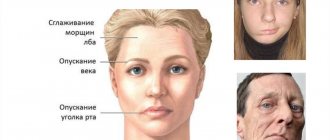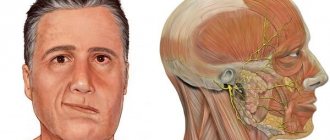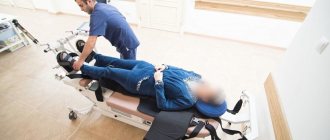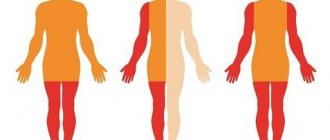Healthy sleep is one of the main factors in a person’s well-being. It is not always possible to get enough sleep or sleep the required 8 hours every day. Of course, there are also stresses, failures at work, and the brain scrolls through depressing thoughts half the night. But what to do when you manage to fall asleep without problems, but are tormented by nightmares or such a phenomenon as sleep paralysis? In this state, you cannot move, you cannot shout, or say anything, and all this is accompanied by seemingly mystical visions. This is really alarming and frightening for any person, especially a child who has encountered such burning in his life for the first time. In this article we will talk about sleep paralysis (awakening cataclepsy), how terrible it is, and how it affects the general condition of a person.
Awakening cataclepsy can occur not only for physiological, but also for psychological reasons
What is sleep paralysis
First you need to understand what sleep paralysis actually is. Sleep paralysis is a condition in which temporary stupor appears while the brain is already in the active phase and the body is completely or partially paralyzed. This condition appears during falling asleep (the moment of falling asleep) or awakening. Sleep paralysis is also called sleep stupor or awakening cataplexy.
Such conditions are studied by the branch of medicine – somnology. Somnologists generally believe that sleep paralysis occurs when dreaming and waking occur. Sleep paralysis usually occurs upon awakening (coming out of the sleep phase), when the dreaming stage ends, or before falling asleep. However, cases of sleep paralysis before falling asleep are much less common. The dreaming stage is called the REM stage of sleep, during which all a person’s muscles completely relax, and in sleep paralysis, this relaxation is maintained while the brain is active.
There are currently no accurate statistics on sleep paralysis. This may mean that actual cases of paralysis are much higher than the officially reported 5-8%. If you ask your friends if they have ever dreamed of sleep paralysis, explaining its symptoms, you will probably meet a couple of acquaintances who have experienced this phenomenon.
What does it look like
For understanding, I will give an example: a person realizes that he has woken up, his thoughts and consciousness are clear, however, if he wants to turn over, the body does not obey, and the muscles seem to be paralyzed. The person lies motionless, unable to speak or call for help. Moreover, often with sleep paralysis, a person begins to notice dark figures that stand next to the bed or sit nearby, sometimes it feels as if they are sitting right on the chest. At the same time, the heart begins to beat quickly, the person may choke and hear strange sounds and buzzing. Directly in this state, when you wake up, you experience anxiety or an attack of anxiety (fear, rapid heartbeat, anticipation or feeling of something bad, etc.). This state lasts from 10 seconds to 2 minutes, after which the ability to move again appears, the heart rate is restored and the condition returns to normal.
Many people confuse what they see during sleep paralysis with mysticism and paranormal phenomena.
What causes sleep paralysis
In most cases, sleep paralysis occurs when a person is lying on their back while sleeping. The state of sleep paralysis is provoked in all people by various pathologies and conditions of the nervous system, as well as a number of other reasons. The causes of sleep paralysis include severe stress, stimulation of the nervous system, disruption of the biological clock, mental disorders, and others. Experts include factors that provoke sleep paralysis:
Depressive conditions of any nature and severity
Arterial hypertension, hypertension (high blood pressure)
Increased physical activity
Post-traumatic stress disorder
Neurodegenerative diseases (Parkinson's disease, Alzheimer's disease, dementia and the like)
Diseases of the nervous system (narcolepsy or other disorders associated with sleep pathology)
Migraine, frequent headaches, epilepsy
Use of pharmacological drugs, toxic effects on the nervous system (substance abuse, drug or alcohol addiction, taking tranquilizers or antidepressants)
Emotional or physical overload when the brain does not rest
Somnambulism (sleep disorders in which a person performs certain actions while asleep)
Anxiety and anxiety disorders
Mental illnesses, disorders. These include bipolar disorders, schizophrenia and other diseases that are characterized by sleep disorders, nervous system disorders, and neuronal oscillations.
Fears, traumas, which are also accompanied by nightmares
Is sleep paralysis dangerous?
Sleep paralysis has been known to mankind since ancient times; it is also called old witch syndrome. Its appearance was associated with the action of black magic, evil spirits, demons and other evil spirits. About 40% of people have experienced it at least once. And in most cases it does not affect the general health of a person.
That is why it does not pose any particular danger to humans, although anxiety and emotional shock after what they saw can affect the human psyche.
A person’s fragile psyche can lead to the fact that upon waking up, a person is convinced to experience a paranormal presence
Competition “Bio/Mol/Text”-2020/2021
This work was published in the “Free Topic” category of the “Bio/Mol/Text” competition 2020/2021.
The general partner of the competition is the annual biotechnology conference BiotechClub, organized by the international innovative biotechnology company BIOCAD.
The sponsor of the competition is SkyGen: a leading distributor of life science products on the Russian market.
Competition sponsor: the largest supplier of equipment, reagents and consumables for biological research and production.
"Book" sponsor of the competition - "Alpina Non-Fiction"
Imagine opening your eyes just before dawn, trying to roll over in bed, and suddenly realizing that you are completely paralyzed. Lying helplessly on your back and unable to scream for help, you notice sinister figures lurking in your bedroom. As they approach the bed, your heart begins to beat faster and you feel like you're suffocating. You hear a buzzing sound and feel electrical impulses throughout your body. After a moment, the visions disappear and you can move again. Horrified, you think about what just happened. The above experience is an episode of sleep paralysis accompanied by hypnopompic hallucinations [1]. This frightening description has been interpreted in various cultural contexts since the time of the ancient Greeks, with a variety of spiritual and supernatural explanations ranging from witchcraft and evil spirits to aliens [2], [3]. Modern medical explanations of SP are not so colorful, but they help us understand the problem much more deeply.
The artist Henry Fuseli dedicated a series of four paintings to this phenomenon - “Nightmare”. The embodiment of the nightmare is personified by the dissolute demon of the mythology of medieval legends - an incubus sitting on the chest of a young girl. The tone of the picture evokes a depressing feeling, plunging the observer into an atmosphere of hopelessness and horror, making one feel the full severity of the charming girl’s condition under the pressure of a “sleepy stupor.”
What happens with sleep paralysis
As previously mentioned, sleep paralysis occurs before falling asleep or upon awakening. What happens with sleep paralysis?
Doctors explain the occurrence of paralysis as follows: in the REM sleep phase, the human body falls into numbness and becomes paralyzed. At this moment, consciousness, visual organs and organs whose work is necessary to maintain life remain active. In this state, the body is completely relaxed and ready for further rest and unloading of brain activity.
The state of sleep paralysis appears when there is a failure in the activity of brain mediators, which do not give a signal in time to turn on the muscles. This results in a temporary stupor, which explains the delay in the functioning of the muscles and brain. A person consciously feels that he has woken up, but the body and muscles at this moment do not yet obey him - the dream is mixed with reality.
People who have experienced paralysis have similar descriptions of what happened. Silhouettes, faces, distorted human bodies, hands, and distortion of reality may appear. At the same time, such visions are felt as absolutely real. Sometimes such sleep paralysis is accompanied by special sound deformations - clapping, steps, jumping and other temporary sounds that frighten the person waking up.
Causes
The exact causes of narcolepsy are not well understood. According to a number of experts, they are based on a lack of a biologically active substance in the brain, which regulates the processes of falling asleep and waking up. Factors that contribute to the development of this disease are often skull trauma, severe debilitating infections, and severe fatigue. Sometimes the disease is associated with the function of the endocrine glands, especially with a disorder of the pituitary gland. In some cases, narcolepsy runs in families. Psychiatric and psychological problems are not the cause of narcolepsy.
The Scientific Explanation of Sleep Paralysis
Thanks to scientific research, it has been noted that paralytic sleep can occur in more than 30% of a completely healthy population who do not have mental disorders. The first cases of paralysis occur on average in people aged 16–17 years. Women are slightly more likely to experience sleep paralysis - 19%, and less often among men - 15%. It is important to understand that such phenomena also occur in young children, but most often parents reduce what the child describes to childish impressionability and fantasy.
The mechanism of occurrence from a scientific point of view is explained by many scientific theories, which we will consider with you further.
- The first theory is based on heredity. In the process of mutation of the gene that is responsible for circadian rhythms (fluctuations in the biological processes of the human body associated with the transitions of day and night), changes occur in the advanced phase of sleep.
- Clusters of cells. Mediators located in the brain area accumulate in groups without forming a single center. Thus, some mediators work separately, which leads to disruption of the muscles and consciousness.
- Activation of brain neurons. This theory is based on the fact that nonspecific activation of neurons occurs in the brain, forming two centers that are responsible for the phases of sleep. Such nerve centers are located in the diencephalon and ensure the functioning of neurons with a significant delay from each other.
The peculiarity of the appearance of sleep paralysis while sleeping on the back is explained by scientists by the fact that in this position the blood drains from the frontal lobes of the brain - the person becomes prone to hallucinations. Oxygen starvation also provokes the occurrence of this condition. Hypoxia entails disruptions in blood circulation, respiratory processes, and the appearance of convulsive conditions.
People who have experienced sleep paralysis note that it most often occurs on the back
Symptoms of sleep paralysis
The symptoms of sleep paralysis are different for everyone who experiences the condition. Experts divide the symptoms and signs of night paralysis into primary and secondary.
Primary symptoms include the following:
- Inability to move. Paralysis affects all major muscle groups and the person is unable to move.
- Inability to utter any words or even move your lips.
- Semi-conscious or conscious state. That is, during sleep paralysis, a person remains conscious and is able to remember the entire episode. Or, in the case of a semi-conscious state, he is partially aware of the reality of what is happening.
- Perception of the external world. Thus, a person in night paralysis fully perceives his environment, things, colors, materials, and so on.
Experts include secondary symptoms:
- Heavy, labored breathing. Difficulty breathing can be caused by the very position in which a person fell asleep, panic attacks, pressure in the chest/on the chest.
- Pressure in or on the chest. This symptom is associated with difficulty breathing. A person feels pressure on the chest, similar to a pile of something on top. Many people describe this condition as “like someone sitting on their chest.”
- Feeling of uncontrollable fear. An incomprehensible state, the inability to speak and move can cause anxiety and panic, which are accompanied by the body's natural reaction - fear.
- Feeling helpless. Most of those who have experienced sleep paralysis note that during the period of paralysis they experienced absolute helplessness. It is also associated with uncontrollable panic, fear and cessation of motor functions.
- Hallucinations. All cases of sleep paralysis are accompanied by various kinds of hallucinations. These hallucinations can affect the auditory, visual, and tactile senses. For example, with auditory hallucinations a person hears buzzing, crackling, rustling, and voices. With visual ones, they see objects, creatures, people that do not exist in reality. Some experience olfactory hallucinations of various kinds, often in the form of smells.
- Mystical and unusual sensations. Mysticism is explained by the fact that consciousness is confused with dreams; the human psyche “draws” images that usually correspond to the disorders and fears that a person experiences, for example, when under prolonged stress. Some cases are accompanied by sensations of mystical creatures, a feeling that a person is swimming or flying, soaring.
Symptoms of sleep paralysis are the same for all survivors
Signs
The phenomenon of sleep stupor was studied by Allan Chain, a psychologist at the Canadian University of Waterloo, and his colleagues. These researchers divided the anamnestic data on the experiences accompanying the phenomenon into three independent groups:
Hallucinations when falling asleep
- fear, anxiety, feeling of someone else's presence, hallucinations (visual and auditory);
- “unusual out-of-body sensations”: flying, soaring, feeling of bliss;
- difficulty breathing, pressure on the chest, chest pain.
The most common sensations experienced by patients were anxiety and the experience of someone else's presence. A physiological explanation can be given for this: the sensations are caused by the suppression of muscle tone during REM sleep, and the visions are an attempt by the brain to identify the basis for atypical experiences.
The second group includes:
- feelings of upliftment;
- lifting off the ground;
- slip;
- flight;
- spinning;
- moving through a narrow tunnel.
All these sensations are explained by the fact that the vestibular apparatus remains active during REM sleep. Information about the position that the body occupies does not enter the brain, which is what is felt like flight, ascent. Unusual feelings accompanying the phenomenon of sleepy stupor can become a source of joyful emotions, even bliss.
Signs of this insomnia are usually observed at the time of getting up, and occasionally they can appear at the time of going to bed. Many patients feel as if their chest is tight and it is difficult to breathe. In reality they are breathing normally.
Some patients are able to open their eyes during stupor, which cannot be done in normal sleep. The feeling that someone is nearby often accompanies this phenomenon, in some cases even hallucinations occur: people hear or see a creature intending to harm them and do not know what to do.
Types of sleep paralysis
During research into the phenomenon of sleep paralysis, scientists identified two main types, which we will consider later.
- The first type is semi-conscious (hypnagogic). Semi-conscious cases are those that occur when a person begins to fall asleep. An attack of paralysis begins at the junction of wakefulness and sleep.
- Hypnopompic. This type of sleep paralysis occurs upon awakening. A person wakes up, or rather those areas of the brain responsible for active activity, but consciousness itself has not yet returned to normal after the sleep phase. This condition occurs from a sudden awakening, such as noise.
Classification
Based on the time of occurrence of attacks (before waking up or during the period of falling asleep), sleepy stupor is divided into two types.
- Hypnagogic stupor. Characteristic of the moment of falling asleep. It is a rare occurrence. Caused by the onset of REM sleep before the loss of consciousness. Before going to bed, a person feels immobilized.
- Hypnopompic stupor. Develops at the moment of awakening. It is the most common type of this sleep disorder. Sleep paralysis is caused by the inclusion of consciousness while maintaining the low muscle tone inherent in the rapid phase of sleep. Such stupor is combined with vivid emotional shocks and fears that cannot be avoided.
Hallucinations during sleep paralysis
During research conducted in 1999, scientists identified three main types of hallucinations that occur during sleep paralysis: presence, incubus and vestibular-motor hallucinations.
Feeling of presence
This type of hallucination is expressed in sensations of the presence of people, creatures, animals. And also in auditory and visual hallucinations, which can be expressed in the sensation of whispers, steps, door slams, noise or voices and other various phenomena of a hallucinogenic nature.
Hallucinations of a sense of presence are born in the brain center - the amygdala, also called the “fear center”. The active activity of the amygdala is triggered by external stimuli, to which the fear center immediately sends a reaction in the form of fear to protect the body.
The entire amygdala complex in the brain structure includes the amygdala itself, the thalamus, which triggers the activity of the amygdala, the anterior cingulate cortex and intermediate links. Scientists have determined that when projections from the thalamus affect the fear center, the cerebral cortex and its other parts begin to activate a protective function, which causes obsessive hallucinations.
In situations with a real threat, areas of the brain begin to actively develop defensive reactions. Brain activity analyzes the external threat and, if it is not confirmed, the impulses weaken and the activity of the fear center decreases. With sleep paralysis, the analysis of brain activity reaches a dead end and is unable to find a threat. Thus, the fear center does not turn off, and the person experiences overwhelming fear, panic and anxiety during sleep paralysis.
The feeling of presence is the most terrible sensation during sleep paralysis
Incubus
The next type of hallucination has a mysterious name - incubus. In the Middle Ages, an incubus was a name given to a demon-tempter who appeared to young and innocent girls in search of debauchery. Many who have experienced sleep paralysis say they have seen a witch, devil or other demonic creatures sitting on their chest. This is what explains the pressure on the chest and the inability to breathe freely.
During the sleep phase, breathing accelerates and becomes more shallow in some areas. Sleep paralysis occurs precisely at a time when breathing remains shallow, blocking its further passage. When muscles are paralyzed, it is not possible to slow down accelerated breathing - muscular and respiratory resistance arises, which is felt as pressure on the chest.
Thus, stationary muscles send a signal to the brain centers responsible for reactions associated with struggle and survival functions. It is these centers that cause spasms and pain. A person feels that he really feels them, although the body itself remains fine and this is nothing more than a protective reaction of the brain.
With paralysis, you can not only see the entire creature or object, but also parts of the body, such as your hands. It may also seem to you that someone is breaking down a door or a wall - it all depends on the circumstances and the person’s very consciousness.
Vestibular-motor hallucinations
Hallucinations associated with vestibular-motor functions cause a person to experience flying, falling, floating or rising, in some cases floating above the bed. The vestibular system is located in the temporal, frontal and parietal lobes - it is responsible for coordinating all human movements and is close to the centers regulating circadian rhythms in the brain stem. When the vestibular system engages the brain stem, a person experiences movement, floating, and other unusual changes in motor activity.
The nature of the movements depends on which lobe is involved during sleep paralysis:
- The angular gyrus allows for the sensation of floating or the sensation of floating;
- The parietal lobe causes sensations of falling, sliding, or rising.
Another reason for changes in vestibular-motor functions is a weakening or decrease in blood flow to the brain and other lobes - as a result, disturbances in motor and tactile function occur and vestibular-motor hallucinations appear.
Sleep paralysis may cause sensations of levitation.
Symptoms
Night paralysis is a condition in which a person exits the REM phase of sleep, but has not yet entered a period of wakefulness. The phenomenon combines physiological problems and a psychological disorder, accompanied by a number of symptoms:
- Complete immobility of the body, with the exception of the eyes;
- Syndrome of suffocation or heaviness on the chest;
- The apparent presence of third parties, accompanied by an auditory or visual hallucination;
- Fear turning into panic.
All these symptoms are combined in the false stages of the disease. Due to the strong pressure on the chest, the patient feels as if someone is sitting on him and trying to strangle him, which causes even greater fear and aggravates the situation.
Is it possible to die during sleep paralysis?
Sleep paralysis has not been fully studied, and the nature of paralysis is still not clear to either scientists or other physicians. It is unknown whether sleep paralysis is a pathology or a minor deviation from the norm. However, psychologists recommend treating isolated cases as ordinary nightmares or a form of sleepwalking (somnambulism).
A large number of studies have not revealed a single case of death specifically due to sleep paralysis or during it, although if you experience such sensations too often, it makes sense to consult a neurologist and epileptologist.
A person is indeed capable of dying in his sleep, but, as a rule, this happens from a heart attack, stroke or other causes and disorders that lead to cardiac arrest. You also don’t have to worry about breathing problems, because when the level of oxygen in the blood drops, a person immediately wakes up.
Cases of death during sleep do occur, for example, with apnea syndrome, when breathing stops, however, death itself does not occur as a result of stopping breathing, but as a result of its effect on the cardiovascular system. Therefore, scientists answer the question “Is it possible to die during sleep paralysis” unequivocally no.
Diagnostics
The typical clinical picture makes it easy to make the correct diagnosis. The patient is examined during repeated episodes of paralysis, in order to exclude psychiatric and neurological diseases that need to be treated. Consultations with a neurologist, a psychiatrist, polysomnography, and an MSLT test are required.
Neurologist consultation
Usually there are no peculiarities in the neurological status. Sometimes there is lability of emotions, asthenia as a result of background sleep disorders, overwork.
Polysomnography
An episode of decreased muscle tone is recorded via video surveillance. A motionless patient is observed, with open eyes and an expression of horror on his face. Cardiac monitoring reveals changes characteristic of REM sleep (rapid heart rate, shallow and rapid breathing).
You can distinguish the loss of muscle tone during sleep from paroxysms of epilepsy using electroencephalography.
MSLT test
Indicated for suspected excessive daytime sleepiness (narcolepsy). This pathology is confirmed by a shortening of the latency period and the detection of more than 2 episodes of daytime falling asleep.
Examination by a psychiatrist
The doctor talks with the patient, observing his behavior, and conducts psychological testing. An examination by this specialist will help rule out psychiatric pathology. The differential diagnostic search includes other sleep disorders, epilepsy, and psychopathology.
Attacks of daytime sleepiness are accompanied by a disease such as narcolepsy. Somnambulism develops without loss of muscle tone; a person walks and moves in his sleep without regaining consciousness. This is a phenomenon diametrically opposed to sleepy stupor. EEG excludes epilepsy, polysomnography excludes sleep apnea syndrome.
How to help yourself during an attack
The duration of sleep paralysis lasts several seconds or minutes. During this time, nothing terrible happens to the person, but the condition is not the most pleasant. In night paralysis, a person can become aware of what has happened to him if, for example, he is informed about the possibility of such a state or has already experienced it before. Unpleasant and even terrible sensations during paralysis do not please anyone and do not give much pleasure, therefore, to get out of this state on your own, you can take some actions:
- Realize that this state and everything that happens is just the influence of hallucinations. The resulting condition does not occur in reality, but is just a slight disruption of brain activity.
- Try to relax, relax all your muscles. Fear forces a person to tense the whole body more, which only worsens the convulsive and constrictive state.
- Try moving your muscles, such as moving your tongue, moving your lips, blinking, rolling your eyes, or using your fingers and toes.
- If the muscles still do not obey you, distract yourself from what is happening with brain activity in the form of counting, pronouncing words, letters, concepts or other systemic formations.
When recovering from sleep paralysis, it is important to try to gain some ability to move the body.
How to relieve the condition
The panic and horror that a person feels during sleep paralysis are emotions experienced at the animal level. It is very difficult to cope with them, since they defy rational explanation. But man, as a rational being, is capable of this. If a symptom recurs, you must adhere to several rules:
- Try to calm down, stabilize your breathing, pausing between inhalation and exhalation for 1-2 seconds.
- There is no need to immediately try to get up - the brain is not able to react so quickly to the awakening of consciousness and, as a defensive reaction, will further weaken muscle tone.
- After your breathing has stabilized, you should try to realize what is happening. Fear comes when a person is in the gap between sleep and reality. If you force your consciousness to work at full strength, you will realize that hallucinations are nothing more than remnants of dreams.
- After the panic subsides, you can try to move your eyes, fingers, or at least your tongue a little. As a rule, partial mobility is preserved, which will help you get rid of the state of helplessness.
- Before you go back to sleep, you need to calm down. You can wash your face, take a shower, or drink warm, soothing tea.
When a disease occurs in one of the spouses, you need to warn your partner about this and ask to wake him up or calm him down if he notices an attack. Observation of patients has shown that emotions are clearly reflected on the face, so it is not difficult to understand that a person is terrified.
How to avoid sleep paralysis
This transitional state and changes in brain activity during sleep frighten many people, not only those who have already experienced it, but also those who have heard about the possibility of such a phenomenon. How to avoid sleep paralysis or prevent it, you should avoid the following factors that influence its manifestation:
- lack of sleep, insomnia, interrupted sleep;
- uncomfortable environment in the bedroom (this could be see-through curtains, stuffy room, noise and other factors);
- uncomfortable bed or incorrect sleeping position;
- lack of routine, incorrect daily routine;
- poor nutrition (lack of beneficial microelements and lack of vitamins);
- physical or emotional stress;
- alcohol, tobacco or drug addiction;
- taking medications (especially tranquilizers, antidepressants and other medications that affect the nervous system).
Somnologists advise avoiding severe stress, adhering to a healthy and correct lifestyle, then you can avoid not only sleep paralysis, but also many other disorders and diseases.
Prognosis for narcolepsy
Narcolepsy is a disease that occurs over a long period of time. Symptoms of this disease can vary in severity throughout a person's life. Symptoms usually worsen over time or become stable. However, drowsiness may become a permanent condition that requires medication. In some cases, cataplexy and other symptoms may decrease or disappear over time.
Various factors influence the symptoms a patient experiences, including:
- irregular sleep-wake schedule;
- the use of substances that affect the central nervous system;
- brain infections;
- sleep disorders such as sleep apnea, periodic limb movement syndrome, etc.
To improve the quality of life and reduce the symptoms of the disease, you need to regularly visit the doctor, follow a clear sleep-wake schedule, and use the medications prescribed by the doctor.
A doctor who specializes in sleep disorders can recognize the symptoms of narcolepsy, evaluate you, and prescribe treatment.
Is it possible to completely get rid of sleep paralysis?
Research into night paralysis shows that most cases first appear in people between 16 and 30 years of age, and typically resolve before age 30 to 35. However, if you are concerned about such attacks, it makes sense to start an examination and consult a psychotherapist or neurologist.
A specialist may advise you to keep a diary that includes how you feel before bed, stressful situations, medications you take, and other possible factors that influence the occurrence of sleep paralysis and help you get rid of it.
As a rule, when a person normalizes his lifestyle, organizes his daily routine and minimizes acceptable stress, the attacks stop.
Severe, especially prolonged cases can continue even after the restoration of lifestyle. In such cases, the doctor prescribes antidepressants. Remember that taking any medications on your own without consulting a doctor can pose a threat to your physical and mental health.
A specialist can help determine the causes of brain overload
Doctor's recommendations
Since sleep disorders are most often associated with an unhealthy lifestyle, experts recommend reconsidering your worldview and creating a personal schedule in such a way that there is time to maintain health:
- Stabilize the schedule, depending on the time of work, so that the body gets used to the same regime;
- Get a smart alarm clock that turns on during fast-wave sleep;
- Provide the body with normal physical activity at least 3-4 times a week;
- Give up bad habits and turn to proper nutrition.
If sleep paralysis begins to bother you constantly, there is no need to self-medicate or take strong sleeping pills - this will only worsen the situation. The disease requires treatment, so you should consult a doctor who can find the cause of the problem and act on it, and not on the symptom itself.
Treatment of sleep paralysis
Now you know what sleep paralysis is, all its signs and symptoms, and also that paralytic sleep does not pose a particular threat to health. However, in some situations it can lead to psychological disorders and significantly worsen further falling asleep and the quality of sleep itself.
If you or your loved ones experience paralytic dreams, especially those lasting longer than 2-3 minutes and recurring episodes, experts advise seeking medical help. Somnologists will determine the real cause of the attacks and promptly select the appropriate treatment. Experts offer the following treatment methods for sleep paralysis.
Rule out medical factors
Many medications have ambiguous effects on the human body. It is for these purposes that a specialist, when treating a patient with sleep paralysis, conducts a detailed analysis of existing diseases, other medical indications, and also determines the general indicators of the body and possible external influences. External influences primarily include toxic ones, for example, the presence of mold in the room or working with heavy metals.
The doctor will definitely refer you for additional examinations in the form of blood donation or other tests to determine the level of hormones, the balance of vitamins and microelements. It is also necessary to consult with a neurologist and perform brain activity tests to exclude neuralgic causes.
The causes of sleep paralysis may be related to the condition of your body and the medications you are taking.
Create a regular sleep schedule
Create a comfortable sleep schedule for yourself. This is necessary to adjust the time of falling asleep and waking up. This method helps the body establish and get used to a constant, specific sleep time.
Most of those who have experienced sleep paralysis confirm that they did not have a clear sleep pattern and fell asleep and woken up at different times with large fluctuations.
A constant sleep schedule is important for any person, because it is during sleep that the entire body and brain activity are rebooted, in other words, both the brain and the body rest during sleep and allow them to gain strength for the next day.
Minimize possible sleep disturbances
Constant interruptions in sleep are one of the most dangerous reasons that can lead to an episode of sleep paralysis. Scientists conducted an experiment where subjects who had not previously experienced a state of paralytic sleep were awakened at the moment when the brain entered the REM sleep phase. After awakening, the subject fell asleep again and found himself from the wakefulness phase immediately into the REM sleep phase, bypassing the falling asleep phase. Thus, the experiment participants became susceptible to sleep paralysis. That is, frequent waking up at night leads to an increased risk of episodes of paralysis.
Work less at night and let your body rest
Improve your sleep quality
Creating a sleep schedule will help restore the duration and quality of sleep, but improving sleep quality depends on more than just your existing schedule. Experts advise following some rules to improve it:
- Reduce your use of technology and electronic devices before bed. It is best not to use a computer or phone 2-3 hours before bedtime.
- Minimize the effect of radiation on your body. Turn off WI-FI, move your phone away from you, or put it in airplane mode to reduce outgoing radiation.
- Limit any light sources entering your bedroom. Turn off the lights and hang dark, impenetrable curtains on the windows so that the light does not disturb your sleep.
- Reduce the noise level in the area where you fall asleep. We talked about the dangers of frequent waking up earlier, and they also happen from external noise, for example, coming from the street, from neighbors, and so on.
- Increase the comfort of your sleeping area. For example, replace the pillows or mattress.
Increase the amount of sleep
For the positive effect of sleep on human health, doctors advise sleeping 7–9 hours a day. Consider your daily activity; if you are actively involved in sports, then you will need not 7 hours, but 9, to recover.
Adjust your sleeping position
One of the reasons for the occurrence of an attack, as we said earlier, may be the sleeping position “on your back.” Try to find other comfortable sleeping positions, or at least avoid the “on your back” position if you experience bouts of sleep paralysis in it.
It is important that your sleeping position is comfortable and comfortable.
Relax and worry less
Try to relax and be less nervous during the day. This advice has a positive effect not only on the fight against paralysis, but also on your overall health. Anxiety, depression, mental disorders and constant stress have a detrimental effect on the human nervous system.
To reduce stress, try meditating, learn proper deep breathing and relaxation. Control your emotions throughout the day, so you can reduce the impact of stressful situations on your health.
Consider dietary supplements
The most common dietary supplement for improving sleep is melatonin. Melatonin is the main hormone of the pineal gland and helps restore human biological rhythms. In addition to melatonin, herbal dietary supplements, such as valerian root, magnesium and others, are used in the treatment of sleep paralysis.
Review your medications
Check the medications you are taking or have taken for episodes of paralysis. Some medications contain ingredients that have side effects that can cause sleep problems and disturbances. Check with your doctor about the side effects of your drug and how it may affect new episodes of sleep paralysis.
Vitamins and medications help prevent sleep paralysis











